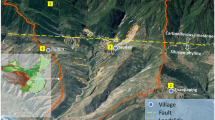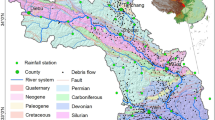Abstract
Debris flow is a natural hazard typically triggered by heavy rainfall. Previous research aimed at forecasting the occurrence of debris flows have led to the development of several rainfall duration-intensity thresholds for different areas using the second-percentile method that allows a missed-alarm probability of up to 2%, while disregarding the occurrence of false alarms. The current study aims to develop rainfall duration-intensity thresholds for debris flow forecasting taking into account both missed alarms and false alarms. Specifically, the new optimization approach seeks to determine the optimal duration-intensity threshold associated with the lowest missed- and false-alarm probabilities combined. In addition to the methodology, a case study is presented to show that the new optimization approach is feasible for determining rainfall duration-intensity thresholds in debris flow forecasting, and is more efficient than the method currently in use, which is associated with a higher probability of missed and false alarms combined.








Similar content being viewed by others
Notes
Equivalent to I = αDβ
Equivalent to I = 2.09D−0.12
References
Aleotti P (2004) A warning system for rainfall-induced shallow failures. Eng Geol 73:247–265
Cannon S, Gartner J, Wilson R, Bowers J, Laber J (2008) Storm rainfall conditions for floods and debris flows from recently burned areas in southwestern Colorado and southern California. Geomorphology 96:250–269
Chen CY, Chen TC, Yu FC, Yu WH, Tseng CC (2005) Rainfall duration and debris-flow initiated studies for real-time monitoring. Environ Geol 47:715–724
Coe J, Kinner D, Godt J (2008) Initiation conditions for debris flows generated by runoff at Chalk Cliffs, central Colorado. Geomorphology 96:270–297
Dahal R, Hasegawa S (2008) Representative rainfall thresholds for landslides in the Nepal Himalaya. Geomorphology 100:429–443
Gabet E, Burbank D, Putkonen J, Pratt-Sitaula B, Ojha T (2004) Rainfall thresholds for landsliding in the Himalayas of Nepal. Geomorphology 63:131–143
Geller RJ, Jackson DD, Kagan YY, Mulargia F (1997) Earthquke cannot be predicted. Science 275:1616
Guo XJ, Cui P, Li Y (2013) Debris flow warning threshold based on antecedent rainfall: a case study in Jiangjia Ravine, Yunnan, China. J Mt Sci 10(2):305–314
Guo XJ, Cui P, Li Y, Ge Y, Mahoney WB (2016) Intensity-duration threshold of rainfall-triggered debris flows in the Wenchuan Earthquake affected area, China. Geomorphology 253:208–216
Guzzetti F, Peruccacci S, Rossi M, Stark C (2007) Rainfall thresholds for the initiation of landslides in central and southern Europe. Meteorog Atmos Phys 98:239–2125
Guzzetti F, Peruccacci S, Rossi M, Stark C (2008) The rainfall intensity–duration control of shallow landslides and debris flows: an update. Landslides 5:3–17
Hong Y, Hiura H, Shino K, Sassa K, Suemine A, Fukuoka H, Wang G (2005) The influence of intense rainfall on the activity of large-scale crystalline schist landslides in Shikoku Island, Japan. Landslides 2:97–105
Iverson RM (1997) The physics of debris flows. Rev Geophys 35(3):245–296
Jibson R (1989) Debris flow in southern Puerto Rico. Geol Soc Am Spec Pap 236:29–55
Larsen M, Simon A (1993) A rainfall intensity-duration threshold for landslides in a humid-tropical environment, Puerto Rico. Geogr Ann Ser A Phys Geogr 75:13–23
Mileti SM, Peek L (2000) The social psychology of public response to warnings of a nuclear power plant accident. J Hazard Mater 75:181–194
Saito S, Daichi N, Hiroshi M (2010) Relationship between the initiation of a shallow landslide and rainfall intensity–duration thresholds in Japan. Geomorphology 118:1125–1175
Tang C, Van AT, Chang M, Chen GQ, Zhao XH, Huang XC (2012) Catastrophic debris flows on 13 August 2010 in the Qingping area, southwestern China: the combined effects of a strong earthquake and subsequent rainstorms. Geomorphology 139-140:559–576
Tang XS, Wang JP, Yang W, Li DQ (2018) Joint probability modeling for two debris-flow variables: copula approach. Nat Hazards Rev 19(2):05018004
Wang JP, Wu YM, Lin TL, Brant L (2012) The uncertainties of a Pd3-PGV onsite earthquake early warning system. Soil Dyn Earthq Eng 36:32–37
Xu Y, Wang JP, Wu YM, Kuochen H (2017) Reliability assessment on earthquake early warning: a case study from Taiwan. Soil Dyn Earthq Eng 92:397–407
Zhang W, Goh ATC (2012) Reliability assessment on ultimate and serviceability limit states and determination of critical factor of safety for underground rock caverns. Tunn Undergr Space Technol 32:221–230
Zhou W, Tang C (2013) Rainfall thresholds for debris flow initiation in the Wenchuan Earthquake-stricken area, southwestern China. Landslides 11(5):877–887
Acknowledgements
The authors are grateful to the editor and reviewers for their valuable comments which helped to greatly improve the quality of the manuscript. Financial support for the research project provided by the Ministry of Science and Technology of the Republic of China (Taiwan) is also gratefully acknowledged (Grant No. MOST106-2218-E-008-013-MY2), as well as funding from the University Grants Committee of Hong Kong (Grant No. T22-603/15 N).
Author information
Authors and Affiliations
Corresponding author
Rights and permissions
About this article
Cite this article
Wu, MH., Wang, J.P. & Chen, IC. Optimization approach for determining rainfall duration-intensity thresholds for debris flow forecasting. Bull Eng Geol Environ 78, 2495–2501 (2019). https://doi.org/10.1007/s10064-018-1314-6
Received:
Accepted:
Published:
Issue Date:
DOI: https://doi.org/10.1007/s10064-018-1314-6




